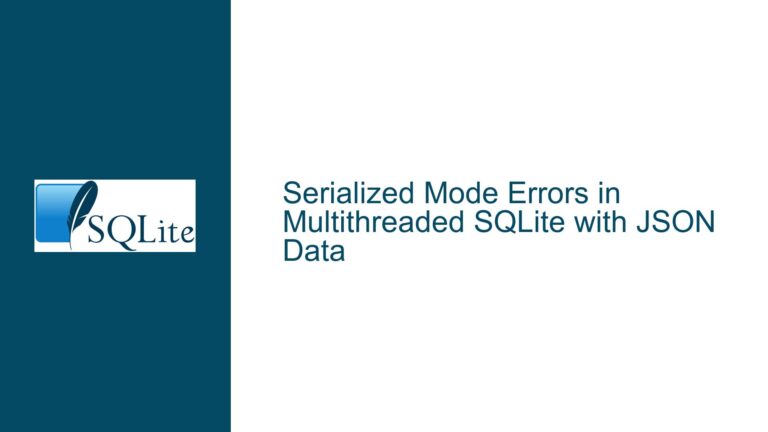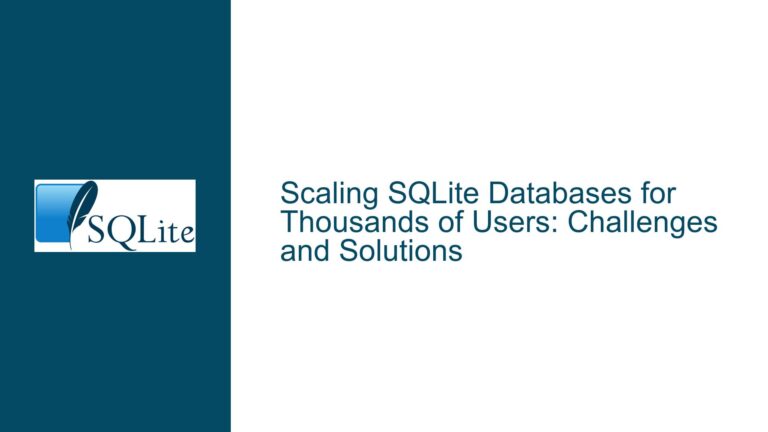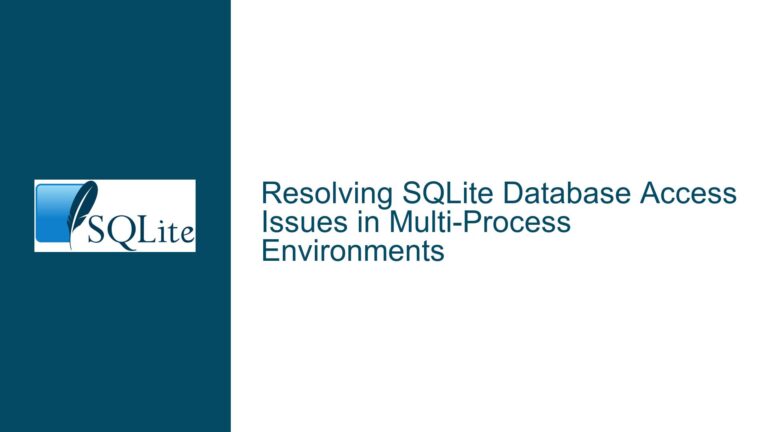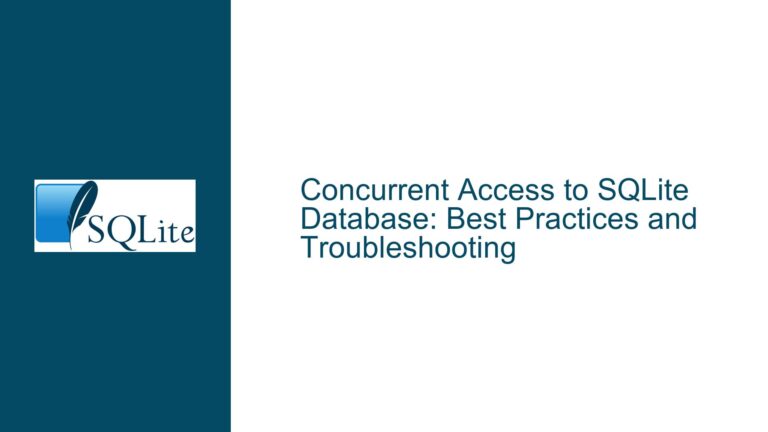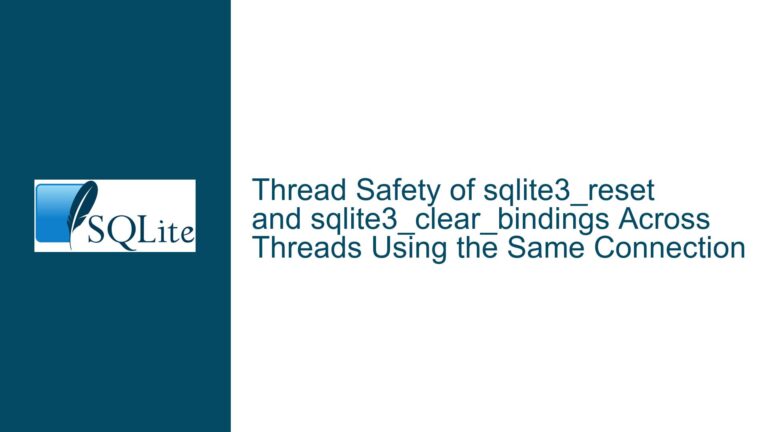Enforcing Exclusive Write Access in SQLite with Concurrent Read-Only Access
SQLite Database Locking Mechanisms and Exclusive Write-Only Requirements
SQLite is a lightweight, serverless database engine that is widely used in applications requiring embedded database functionality. One of its key features is its locking mechanism, which ensures data integrity during concurrent access. However, SQLite’s default locking behavior does not inherently support a scenario where only one process can write to the database while allowing multiple processes to read from it concurrently. This limitation becomes particularly evident when attempting to enforce an exclusive write-only lock, where a single process is designated as the sole writer, and all other processes are restricted to read-only access.
The core challenge lies in SQLite’s locking model, which is designed to balance concurrency and data integrity. By default, SQLite uses a file-based locking system that includes shared, reserved, pending, and exclusive locks. When a process initiates a write operation, it acquires a reserved lock, which prevents other processes from writing but allows them to read. However, once the write operation is committed, the lock is released, and another process can potentially acquire the write lock. This behavior makes it difficult to enforce a persistent exclusive write lock while allowing concurrent read access.
Furthermore, SQLite’s Write-Ahead Logging (WAL) mode introduces additional complexities. WAL mode allows readers to access the database while a writer is actively modifying it, but it does not provide a mechanism to enforce a single writer. In WAL mode, multiple processes can attempt to write simultaneously, leading to potential conflicts or data corruption if not managed properly. This makes it essential to implement application-level controls to enforce the desired locking behavior.
Interrupted Write Operations and Lock Management Challenges
The primary cause of the inability to enforce an exclusive write-only lock in SQLite lies in its lock management system. SQLite’s locking model is designed to be lightweight and efficient, but it does not include built-in support for enforcing a single writer with multiple readers. This limitation is particularly problematic in scenarios where third-party applications or processes may attempt to access the database without adhering to the designated locking protocol.
One of the key issues is the lack of atomicity in lock acquisition and release. When a writer process commits a transaction, it releases its lock, creating a window of opportunity for another process to acquire the write lock. This race condition can lead to situations where multiple processes attempt to write to the database simultaneously, undermining the goal of exclusive write access. Additionally, SQLite’s reliance on file-system-level locks can introduce further complications, especially when the database is accessed over a network file system, where lock feedback may not be reliable.
Another challenge is the handling of process crashes or unexpected terminations. If the designated writer process crashes while holding a lock, the lock may not be released properly, potentially blocking other processes from accessing the database. This necessitates the implementation of robust error handling and recovery mechanisms to ensure that locks are released appropriately in the event of a process failure.
Implementing PRAGMA journal_mode, WAL Mode, and Application-Level Locking Controls
To address the challenges of enforcing an exclusive write-only lock in SQLite, a combination of SQLite configuration settings and application-level controls can be employed. The following steps outline a comprehensive approach to achieving the desired locking behavior:
Configuring SQLite for Exclusive Write Access
The first step is to configure SQLite to use the Write-Ahead Logging (WAL) mode, which provides better concurrency and performance compared to the default rollback journal mode. WAL mode allows readers to access the database while a writer is actively modifying it, but it does not inherently enforce a single writer. To enable WAL mode, execute the following SQL command:
PRAGMA journal_mode=WAL;
In WAL mode, the writer process can hold a write lock while allowing readers to access the database concurrently. However, to enforce exclusive write access, additional application-level controls are required.
Implementing Application-Level Locking Controls
To enforce exclusive write access, the designated writer process must acquire and hold a write lock for the duration of its operation. This can be achieved by using the BEGIN IMMEDIATE transaction mode, which acquires a reserved lock immediately, preventing other processes from writing but allowing them to read. The writer process should begin its transaction as follows:
BEGIN IMMEDIATE;
By holding the BEGIN IMMEDIATE transaction open, the writer process maintains its reserved lock, ensuring that no other process can acquire a write lock. However, this approach has limitations, as the lock is released when the transaction is committed or rolled back. To maintain the lock, the writer process must periodically commit and restart the transaction, introducing potential race conditions.
To mitigate this, the writer process can use savepoints to manage smaller transactions within the larger BEGIN IMMEDIATE transaction. Savepoints allow the writer to commit changes without releasing the reserved lock, ensuring continuous exclusive write access. For example:
SAVEPOINT my_savepoint;
-- Perform write operations
RELEASE SAVEPOINT my_savepoint;
Handling Process Crashes and Lock Recovery
In the event of a process crash or unexpected termination, it is essential to ensure that locks are released properly to prevent blocking other processes. One approach is to implement a watchdog mechanism that monitors the health of the writer process and releases the lock if the process becomes unresponsive. Additionally, the use of SQLite’s sqlite3_unlock_notify API can help detect when a lock is released and trigger appropriate recovery actions.
Enforcing Read-Only Access for Third-Party Processes
To enforce read-only access for third-party processes, the database file’s permissions can be modified to restrict write access. On Unix-like systems, this can be achieved by setting the file permissions to read-only for other users:
chmod 444 database.db
On Windows, the file attributes can be set to read-only using the following command:
attrib +R database.db
However, this approach has limitations, as it restricts write access for all processes, including the designated writer process. To allow the writer process to retain write access while restricting third-party processes, a more sophisticated approach is required. One option is to use a proxy process that mediates access to the database, enforcing the desired locking behavior and permissions.
Using a Proxy Process for Access Control
A proxy process can be implemented to act as an intermediary between the database and all other processes. The proxy process would be responsible for enforcing the exclusive write lock and managing read-only access for other processes. The proxy process would open the database in read-write mode and hold a BEGIN IMMEDIATE transaction to maintain the write lock. Other processes would connect to the proxy process, which would forward their read requests to the database while preventing any write operations.
This approach provides a robust solution for enforcing exclusive write access and read-only access for third-party processes. However, it introduces additional complexity and overhead, as the proxy process must handle all database interactions and ensure proper locking and error handling.
Conclusion
Enforcing an exclusive write-only lock in SQLite while allowing concurrent read-only access is a complex but achievable goal. By combining SQLite’s WAL mode, application-level locking controls, and robust error handling, it is possible to create a system that meets the desired requirements. Additionally, the use of a proxy process can provide a more secure and controlled environment for managing database access. While SQLite’s default locking mechanisms do not inherently support this use case, the techniques outlined above offer a practical solution for applications requiring exclusive write access with concurrent read-only access.

